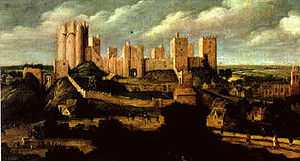Alexander Keirincx


Alexander Keirincx (Antwerp, 23 January 1600–Amsterdam, 1652) was trained as a Flemish Baroque painter who later moved to Utrecht and ultimately to Amsterdam in the Dutch Republic.[1][2] He became a master in Antwerp's guild of St. Luke in 1619,[2] and like his teacher Abraham Govaerts he initially specialized in small cabinet-sized forest landscapes in the manner of Jan Brueghel the Elder and Gillis van Coninxloo.[1] Also like Govaerts, Keirincx's early works typically show history, mythological or biblical subjects within a Mannerist three-color, schematic landscape bracketed by repoussoir trees.[1] However, during the 1620s and '30s his landscapes become increasingly naturalistic, influenced by Dutch tonalism in the manner of Pieter de Molyn, Jan van Goyen and others.[3]
The most singular moment in Keirincx's career was his sojourn in England and commission by Charles I of ten landscape paintings, mainly views of the king's castles and houses in Northern England and Scotland produced between May 1639 and mid-1640.[3] Charles' commission was likely politically motivated, originally intended to celebrate his campaign and victory over the Scots during the first of the Bishops' Wars and when that didn't materialize, a face-saving measure upon the return of his properties by the Scots.[3] One example, Distant View of York at Tate Britain, shows an important site in the campaign of the First Bishops War. The importance of this series and its impact on later painting in Britain is hard to overstate, as Keirincx combined the aesthetic landscape tradition with that of the taste for detailed, topographical views, firmly grounded in Caroline court culture.[3] His are the first "house portraits" which became a well-established trend in painting in Britain by the later 17th-century as practiced for example by Jan Siberechts and Jan Griffier the Elder.[3]
Keirincx's career and his contributions to art history and especially to the development of painting in Britain have long been obscured by mistaken identity, lack of documentation and variant name spellings.[4]
References
- ↑ 1.0 1.1 1.2 Vlieghe, pp. 180–182.
- ↑ 2.0 2.1 Devisscher.
- ↑ 3.0 3.1 3.2 3.3 3.4 Townsend
- ↑ These issues were first sorted out in Richard P. Townsend, Alexander Keirincx, 1600-1652, unpublished thesis, Institute of Fine Arts, New York University, 1988 and later in Richard P. Townsend, "The One and Only Alexander Keirincx: Correcting the Misconceptions," APOLLO, CXXXVIII, October 1993, pp. 220-223.
| Wikimedia Commons has media related to Alexander Keirincx. |
Sources
- Hans Devisscher, "Keirinckx [Carings; Cierings; Cierinx; Keerinckx; Keirincx; Keirings; Keyrincx], Alexander [Alexandre]," Grove Art Online. Oxford University Press, [accessed 11 November 2007].
- Richard P. Townsend, “Alexander Keirincx’s Royal Commission of 1639-40” in the Leids Kunsthistorisch Jaarboek, XXII, University of Leiden, 2003, pp. 137–150.
- Hans Vlieghe, Flemish Art and Architecture, 1585-1700. Pelican History of Art. New Haven: Yale University Press,1998. ISBN 0-300-07038-1
|